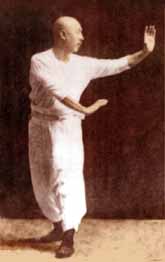Baguazhang
Baguazhang (Chinese: 八卦掌; pinyin: Bāguà Zhǎng) is a traditional Chinese martial arts known for its unique practice of circle walking, intricate hand movements, and philosophical underpinnings rooted in the I Ching (Book of Changes). The name Baguazhang literally translates to "Eight Trigram Palm," referring to the eight trigrams of the I Ching, which are central to the martial art's theoretical foundation.
History[edit | edit source]
Baguazhang was developed during the Qing Dynasty in China by Dong Haichuan (董海川) in the early 19th century. Dong is widely regarded as the founder of Baguazhang, although it is believed that he synthesized pre-existing martial arts with the I Ching's principles. After Dong, Baguazhang was passed down through several generations of masters, each adding their own insights and techniques, resulting in various styles and schools.
Styles and Schools[edit | edit source]
There are several major styles of Baguazhang, each named after its founder or the characteristic it emphasizes. These include:
- Yin Style Baguazhang: Founded by Yin Fu (尹福), known for its aggressive and direct approach.
- Cheng Style Baguazhang: Developed by Cheng Tinghua (程廷华), emphasizing flexibility and flowing movements.
- Li Style Baguazhang: Created by Li Ziming (李子鳴), known for its emphasis on the application of the I Ching principles.
- Fu Style Baguazhang: Founded by Fu Zhensong (傅振嵩), characterized by its integration with other martial arts.
Principles and Practice[edit | edit source]
The practice of Baguazhang is distinguished by its use of circular walking, where practitioners move around the edge of a circle in various stances and speeds. This movement is foundational to Baguazhang, as it helps develop agility, balance, and the ability to apply techniques from any angle.
The martial art also emphasizes the concept of change, inspired by the I Ching, with practitioners learning to adapt their movements fluidly in response to their opponents. Techniques in Baguazhang include strikes, throws, joint locks, and evasions, often executed with the palms, hence the name "Eight Trigram Palm."
Philosophical Underpinnings[edit | edit source]
Baguazhang is deeply rooted in Daoist philosophy, particularly the concepts of change and harmony represented in the I Ching. The eight trigrams symbolize various natural phenomena and are used to guide the practitioner's understanding of movement, strategy, and life itself.
Training[edit | edit source]
Training in Baguazhang involves a combination of solo exercises, including circle walking and form practice, as well as partner drills and sparring. Practitioners also study the theoretical aspects of the art, learning to apply the principles of the I Ching to both martial arts and daily life.
Modern Practice[edit | edit source]
Today, Baguazhang is practiced worldwide, both as a martial art and for its health benefits, including improved balance, flexibility, and mental focus. It is also featured in various cultural exhibitions and martial arts competitions.
Search WikiMD
Ad.Tired of being Overweight? Try W8MD's physician weight loss program.
Semaglutide (Ozempic / Wegovy and Tirzepatide (Mounjaro / Zepbound) available.
Advertise on WikiMD
|
WikiMD's Wellness Encyclopedia |
| Let Food Be Thy Medicine Medicine Thy Food - Hippocrates |
Translate this page: - East Asian
中文,
日本,
한국어,
South Asian
हिन्दी,
தமிழ்,
తెలుగు,
Urdu,
ಕನ್ನಡ,
Southeast Asian
Indonesian,
Vietnamese,
Thai,
မြန်မာဘာသာ,
বাংলা
European
español,
Deutsch,
français,
Greek,
português do Brasil,
polski,
română,
русский,
Nederlands,
norsk,
svenska,
suomi,
Italian
Middle Eastern & African
عربى,
Turkish,
Persian,
Hebrew,
Afrikaans,
isiZulu,
Kiswahili,
Other
Bulgarian,
Hungarian,
Czech,
Swedish,
മലയാളം,
मराठी,
ਪੰਜਾਬੀ,
ગુજરાતી,
Portuguese,
Ukrainian
Medical Disclaimer: WikiMD is not a substitute for professional medical advice. The information on WikiMD is provided as an information resource only, may be incorrect, outdated or misleading, and is not to be used or relied on for any diagnostic or treatment purposes. Please consult your health care provider before making any healthcare decisions or for guidance about a specific medical condition. WikiMD expressly disclaims responsibility, and shall have no liability, for any damages, loss, injury, or liability whatsoever suffered as a result of your reliance on the information contained in this site. By visiting this site you agree to the foregoing terms and conditions, which may from time to time be changed or supplemented by WikiMD. If you do not agree to the foregoing terms and conditions, you should not enter or use this site. See full disclaimer.
Credits:Most images are courtesy of Wikimedia commons, and templates, categories Wikipedia, licensed under CC BY SA or similar.
Contributors: Prab R. Tumpati, MD

